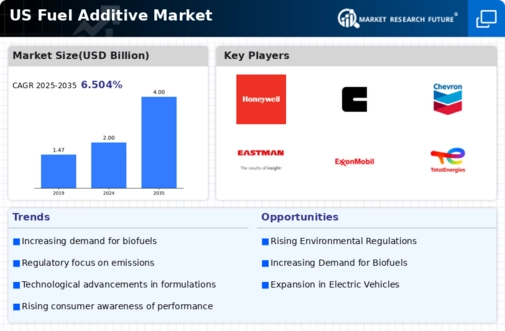The fuel additive market exhibits a dynamic competitive landscape characterized by innovation and strategic partnerships. Key players such as Chevron (US), ExxonMobil (US), and Valvoline (US) are actively shaping the market through their distinct operational focuses. Chevron (US) emphasizes sustainability and has invested in biofuel technologies, aiming to reduce carbon emissions while enhancing fuel efficiency. ExxonMobil (US) continues to leverage its extensive research capabilities to develop advanced additives that improve engine performance and reduce environmental impact. Valvoline (US), on the other hand, is focusing on expanding its product portfolio through strategic acquisitions, thereby enhancing its market presence and catering to diverse consumer needs. Collectively, these strategies indicate a shift towards environmentally friendly solutions and technological advancements, which are pivotal in shaping the competitive environment.
In terms of business tactics, companies are increasingly localizing manufacturing to reduce supply chain vulnerabilities and optimize operational efficiency. The market structure appears moderately fragmented, with several players vying for market share. However, the collective influence of major companies like Chevron (US) and ExxonMobil (US) suggests a trend towards consolidation, as these firms seek to enhance their competitive edge through strategic collaborations and technological investments.
In November 2025, Chevron (US) announced a partnership with a leading biofuel startup to develop next-generation fuel additives derived from renewable sources. This collaboration is strategically significant as it positions Chevron (US) at the forefront of the sustainable fuel movement, potentially attracting environmentally conscious consumers and aligning with regulatory trends favoring low-carbon solutions.
In October 2025, ExxonMobil (US) unveiled a new line of fuel additives designed to enhance engine cleanliness and efficiency. This launch is indicative of ExxonMobil's commitment to innovation, as it seeks to address the growing consumer demand for high-performance fuels while simultaneously reducing emissions. The introduction of these additives may strengthen ExxonMobil's market position by appealing to both commercial and individual consumers looking for reliable fuel solutions.
In September 2025, Valvoline (US) completed the acquisition of a smaller additive manufacturer, which is expected to bolster its product offerings and market reach. This strategic move not only enhances Valvoline's competitive positioning but also reflects a broader trend of consolidation within the industry, as companies seek to diversify their portfolios and leverage synergies from acquired technologies.
As of December 2025, the fuel additive market is increasingly defined by trends such as digitalization, sustainability, and the integration of artificial intelligence in product development. Strategic alliances are becoming more prevalent, as companies recognize the need to collaborate in order to innovate and meet evolving consumer expectations. Looking ahead, competitive differentiation is likely to shift from price-based strategies to a focus on innovation, technology, and supply chain reliability, as firms strive to establish themselves as leaders in a rapidly changing market.























Leave a Comment